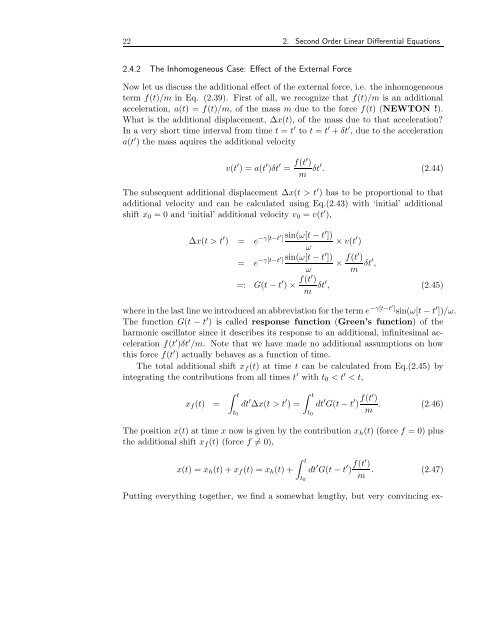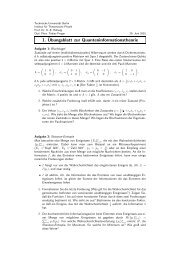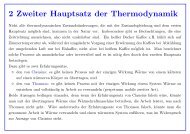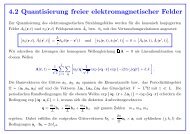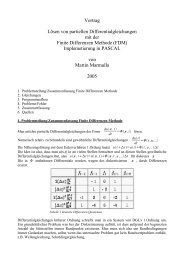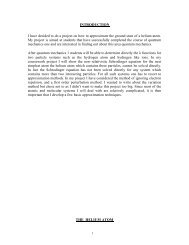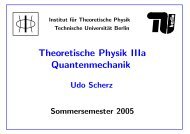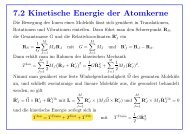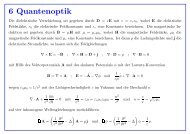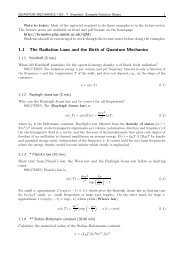2. SECOND ORDER LINEAR DIFFERENTIAL EQUATIONS
2. SECOND ORDER LINEAR DIFFERENTIAL EQUATIONS
2. SECOND ORDER LINEAR DIFFERENTIAL EQUATIONS
You also want an ePaper? Increase the reach of your titles
YUMPU automatically turns print PDFs into web optimized ePapers that Google loves.
22 <strong>2.</strong> Second Order Linear Differential Equations<br />
<strong>2.</strong>4.2 The Inhomogeneous Case: Effect of the External Force<br />
Now let us discuss the additional effect of the external force, i.e. the inhomogeneous<br />
term f(t)/m in Eq. (<strong>2.</strong>39). First of all, we recognize that f(t)/m is an additional<br />
acceleration, a(t) = f(t)/m, of the mass m due to the force f(t) (NEWTON !).<br />
What is the additional displacement, ∆x(t), of the mass due to that acceleration?<br />
In a very short time interval from time t = t ′ to t = t ′ + δt ′ , due to the acceleration<br />
a(t ′ ) the mass aquires the additional velocity<br />
v(t ′ ) = a(t ′ )δt ′ = f(t′ )<br />
m δt′ . (<strong>2.</strong>44)<br />
The subsequent additional displacement ∆x(t > t ′ ) has to be proportional to that<br />
additional velocity and can be calculated using Eq.(<strong>2.</strong>43) with ‘initial’ additional<br />
shift x0 = 0 and ‘initial’ additional velocity v0 = v(t ′ ),<br />
∆x(t > t ′ ) = e −γ[t−t′ ] sin(ω[t − t′ ])<br />
ω<br />
= e −γ[t−t′ ] sin(ω[t − t′ ])<br />
ω<br />
× v(t ′ )<br />
× f(t′ )<br />
m δt′ ,<br />
=: G(t − t ′ ) × f(t′ )<br />
m δt′ , (<strong>2.</strong>45)<br />
where in the last line we introduced an abbreviation for the term e −γ[t−t′ ] sin(ω[t − t ′ ])/ω.<br />
The function G(t − t ′ ) is called response function (Green’s function) of the<br />
harmonic oscillator since it describes its response to an additional, infinitesimal acceleration<br />
f(t ′ )δt ′ /m. Note that we have made no additional assumptions on how<br />
this force f(t ′ ) actually behaves as a function of time.<br />
The total additional shift xf (t) at time t can be calculated from Eq.(<strong>2.</strong>45) by<br />
integrating the contributions from all times t ′ with t0 < t ′ < t,<br />
xf(t) =<br />
t<br />
dt ′ ∆x(t > t ′ t<br />
) =<br />
t0<br />
t0<br />
dt ′ G(t − t ′ ) f(t′ )<br />
. (<strong>2.</strong>46)<br />
m<br />
The position x(t) at time x now is given by the contribution xh(t) (force f = 0) plus<br />
the additional shift xf(t) (force f = 0),<br />
x(t) = xh(t) + xf (t) = xh(t) +<br />
t<br />
t0<br />
dt ′ G(t − t ′ ) f(t′ )<br />
. (<strong>2.</strong>47)<br />
m<br />
Putting everything together, we find a somewhat lengthy, but very convincing ex-


